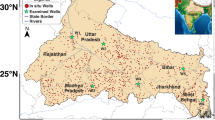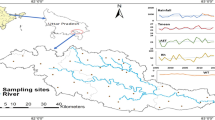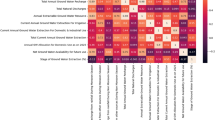Abstract
Groundwater is an important component of water resources. Excessive exploitation can lead to water scarcity, while excessive groundwater can cause problems such as terrain collapse. Therefore, it is crucial to obtain timely information on groundwater levels (GWL) and make predictions accordingly. Previous methods, considering only the time series of the sites did not consider the spatial relationships between the sites due to the difficulty to handle unstructured site location data. This paper proposes a GWL prediction model based on GCN-LSTM, each GWL site is regarded as a node of the graph. The spatial topological relationship between the sites is determined through Pearson correlation coefficient and Euclidean distance, and the adjacency matrix is constructed. Using the graph convolutional neural network (GCN) mines the spatial characteristics between groundwater level sites, and then inputs the time series data with spatial characteristics into the long short-term memory neural network (LSTM) to mine the temporal characteristics to predict groundwater. In this paper, the GWL data from 18 sites were selected to predict GWL in the next three day. The mean absolute error (MAE), mean squared error (MSE), and root mean squared error (RMSE) are used as evaluation criteria, the mean absolute error of the predicted GWL was 0.13 m, the mean square error was 0.02 m, and the root mean square error was 0.14 m, the proposed prediction model has lower errors than the LSTM and TGCN models. Compared with the long short-term memory network model, this model can shorten the training time and improve the prediction efficiency. And it can reflect the dynamic changes of GWL at multiple sites more efficiently and obtain the changing trend of GWL in the entire region, which has certain practical application value.











Similar content being viewed by others
REFERENCES
Bai, T. and Tahmasebi, P., Graph neural network for groundwater level forecasting, J. Hydrol., 2023, vol. 616, p. 128792.
Cao, N., Xu, G.Q., Zhang, J.Q., Zheng, Y.Q., and Xiong, P., Research on groundwater level prediction based on broad learning, Shuili Fadian, 2022, vol. 48, pp. 28–32. (in Chinese)
Collados-Lara, A.J., Pulido-Velazquez, D., Ruiz, L.G.B., Pegalajar, M.C., Pardo-Igúzquiza, E., and Baena-Ruiz, L., A parsimonious methodological framework for short-term forecasting of groundwater levels, Sci. Total Environ., 2023, vol. 881, p. 163328.
Gharehbaghi, A., Ghasemlounia, R., Ahmadi, F., and Ahmadi, F., Groundwater level prediction with meteorologically sensitive Gated Recurrent Unit (GRU) neural networks, J. Hydrol., 2022, vol. 612, p. 128262.
Ghasemlounia, R., Gharehbaghi, A., Ahmadi, F., and Saadatnejadgharahassanlou, H., Developing a novel framework for forecasting groundwater level fluctuations using Bi-directional Long Short-Term Memory (BiLSTM) deep neural network, Comput. Electron. Agric., 2021, vol. 191, p. 106568.
Hu, S. and Li, C.J., Present situation and countermeasures of groundwater resources development and utilization in Zhengzhou city, Water Resour. Develop. Manag., 2020, vol. 04, pp. 33–37.
Ma, J.W., Yan, J.H., Sun, R.W. and Liu, B.X., Prediction model of PM2.5 concentration based on LSTM-GCN, Zhongguo Huanjing Jiance, 2022, vol. 38, pp. 153–160 (in Chinese).
Najafabadipour, A., Kamali, G., and Nezamabadi-pour, H., The innovative combination of time series analysis methods for the forecasting of groundwater fluctuations, Water Resour., 2022, vol. 49, pp. 283–291.
Qi, H., Research on Spatial and Temporal Prediction Method of Groundwater Level in Changwu Area Based on KNN-LSTM Model, Nanjing: Nanjing Normal Univ., 2020 (in Chinese).
Shang, L.Y., Zhang, Y., Ye, Q.H., Speir, S.L., et al., CrowdWaterSens: An uncertainty-aware crowdsensing approach to groundwater contamination estimation, Pervas. Mobile Comput., 2023, vol. 92, pp. 101788.
Sun, H.J., Zhao, Z.H., Huang, L.X., Xing, L.T., Hao, J., and Luo, Z.J., Application of multi-variable LSTM neural network model for groundwater levels prediction, Renmin Huanghe, 2022, vol. 44, pp. 69–75 (in Chinese).
Tao, T., Xie, G., He, R. et al., Groundwater storage variation characteristics in North China before and after the South-to-North Water Diversion Project based on GRACE and GPS Data, Water Resour., 2023, vol. 50, pp. 58–67.
Tao, Y., Zhu, X.J, Yang, L., Multi-sensor data fusion based on Pearson coefficient and information entropy, Journal of Chinese Computer Systems, 2023, vol. 44, pp. 1075–1080.
Tian, D.Y., Zhang, C.Y., Cheng, Y.H., and Zhang, S.L., Study on variations of groundwater depth in Zhengzhou City after operation of Middle Route Project of South-to-North Water Diversion, Renmin Huanghe, 2023, vol. 45, pp. 76–82+102 (in Chinese).
Vu, M.T., Jardani, A., Massei, N., et al. Reconstruction of missing groundwater level data by using Long Short-Term Memory (LSTM) deep neural network, J. Hydrol., 2020, vol. 597, p. 25776.
Yang, J.F., Liu, J.M., Chen, L., Forecast of the minimum depth of groundwater in irrigation district based on the Residual Model of GM (1,1), Renmin Huanghe, 2011, vol. 33, pp. 101–102+105 (in Chinese).
Yu, L.M., Yan, W.G., Gong, D.Z., et al., Temporal and spatial distribution prediction of shallow groundwater level based on ELM model, Nongye Jixie Xuebao, 2017, vol. 48, pp. 215−223 (in Chinese).
Zhu, H.S., Wang, J.H., and Chen, X., Application of RBF Neural Network Model in groundwater depth prediction, Renmin Huanghe, 2020, vol. 42, pp. 50–54 (in Chinese).
Zhu, Q.M., Li, H.Y., Wang, Z.Q., Chen, J.F., and Wang, B., Short-term wind power forecasting based on LSTM, Power System Technol., 2017, vol. 41, pp. 3797–3802.
ACKNOWLEDGMENTS
We thank the Zhengzhou Water Conservation Center for providing the data from the groundwater level station.
Funding
This work was supported by the Zhengzhou groundwater level remote monitoring system and equipment upgrading project. (Grant number HNSH2022-037).
Author information
Authors and Affiliations
Corresponding author
Ethics declarations
The authors of this work declare that they have no conflicts of interest.
Additional information
Publisher’s Note.
Pleiades Publishing remains neutral with regard to jurisdictional claims in published maps and institutional affiliations.
Rights and permissions
About this article
Cite this article
Liu, M.T., Chen, X.K., Wang, G.H. et al. Short-Term Prediction of Groundwater Level Based on Spatiotemporal Correlation. Water Resour 51, 207–220 (2024). https://doi.org/10.1134/S0097807823601346
Received:
Revised:
Accepted:
Published:
Issue Date:
DOI: https://doi.org/10.1134/S0097807823601346




